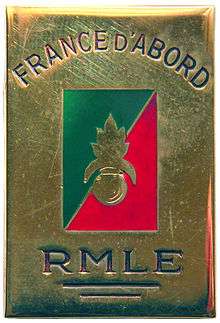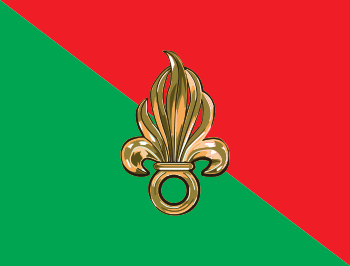Garibaldi Legion (French Foreign Legion)
| Garibaldi Legion | |
|---|---|
|
4th Marching Regiment of the 1st Foreign Regiment 4e régiment de marche du 1er étranger | |
 Garibaldi Legion | |
| Active | 1914–15 |
| Country | France |
| Allegiance | Triple Entente |
| Type | Light Infantry |
| Size | 2,171 men ca. |
| Part of |
Armée de terre French Foreign Legion |
| Engagements | Battle of the Argonne |
| Disbanded | 1915 |
| Commanders | |
| Current commander | Giuseppe Garibaldi II |
The Garibaldi Legion (official name 4e régiment de marche du 1er étranger) was a unit of the French Foreign Legion which formed the Marching Regiment of the Foreign Legion composed entirely all of Italian citizens, who fought in France in World War I against the Germans.
History
With the outbreak of World War I in the fall of 1914, Giuseppe Garibaldi II (also known as Peppino Garibaldi) and his four brothers went to England to offer their services. The English said no so he went to Paris and agreed to accept an Italian unit. With French permission he created the Garibaldi Legion to fight for France. It was enthusiastically joined by members of the Italian Youth Republican Legion, veterans of previous campaigns, Greece and South Africa, Mazzini and trade unionists also joined. Instead of joining the French Army the Paris government insisted that the Garibaldi unit join the French Foreign Legion.[1]
The body of Italian volunteers consisted of approximately 2,114 men and 57 officers, of whom half were migrants living in France, and was built into the 4th Marching Regiment of the 1st Foreign Regiment with the standard uniform of the legionaries, with one small difference a red shirt the partisans wore under their jacket.
The Legion was briefly trained in Montelimar, Nîmes and Montboucher and then transferred on November 11, 1914 to Mailly, where Lieutenant Colonel Giuseppe Garibaldi II formally took over the command.
Used on the front of the Argonne in risky enterprises and bayonet assaults, the Legion on December 26, 1914, fought in Belle Etoile, near Bois de Bolante, a bloody battle from which the volunteers were victorious. Here Peppino was almost killed, however, a brother, Lieut. Bruno Garibaldi died in the charge. When the Italian public found out it enraged them.[1][2] After Bruno was killed 300,000 people took part in his January 6, 1915 funeral procession. French, British, Russian, Belgian and Serbian ambassadors were in attendance.[3] The second battle of the Legion in Argonne, took place January 5, 1915 Four-de-Paris, where it suffered heavy casualties including another brother of Peppino, Constantino Garibaldi.[1] During Bruno's funeral news arrived of Constantino's death.[3]
On March 6, 1915 the Legion, given the general mobilization in Italy, was dissolved and the IV Regiment marched back to Avignon. All Italian legionnaires were then sent back to Italy to fight against the Austrians.
All told from fighting under French command the Garibaldi Legion had 300 dead, 400 injured and a thousand sick. Among the fallen officers December 26, 1914 include: the lieutenant Lamberto Duranti from Ancona; Courtes Chausses ( Lachalade ); Lieutenant Gregory Trombetta from Milan, killed at Bois de Bolante (Lachalade); Lieutenant Paul Muracciole by Gatti-of-Vivarium dead near Le Claon (Lachalade); the lieutenant Pasquale Marino, who died at Bois de Bolante. Among the wounded partisans there was Giuseppe Chiostergi Senigallia, elected deputy in the first parliament of the Italian Republic. Lazare Ponticelli, Italian immigrant in France and volunteer assigned to the Legion Garibaldi, became a French citizen in the 1930s and is remembered in France as le dernier Poilu, the last of the veterans.
Today the Legion in Italy is an association of veterans and people who share the ideals of the Republic Garibaldi.
See also
Bibliography
| Wikimedia Commons has media related to Garibaldi Legion. |
- Notes
- 1 2 3 Fitzwilliam Museum 2015
- ↑ Alaska Daily Empire 1914, p. 1
- 1 2 Associated Press 1914, p. Front Page
- References
- Associated Press (January 7, 1915). "Receives News of Second Death While Funeral Services are Being Held". Anderson Daily Intelligencer. Anderson, Anderson, South Carolina: William Banks. ISSN 2166-9651. OCLC 27828051. Archived from the original on January 7, 1915. Retrieved January 5, 2015.
- Fitzwilliam Museum (2015). "Italy and France. The heroic death of Bruno Garibaldi". Fitzwilliam Museum. Retrieved January 5, 2015.
- Alaska Daily Empire (January 5, 1914). "Italian Thirst To Get Into War". The Alaska Daily Empire. Juneau, Alaska.
External links
- Legion Garibaldina in Tesauro's New subject headings, BNCF
